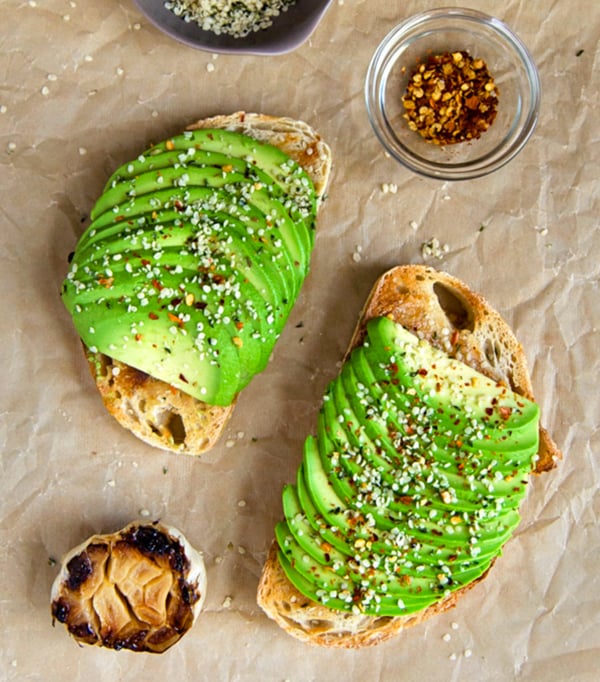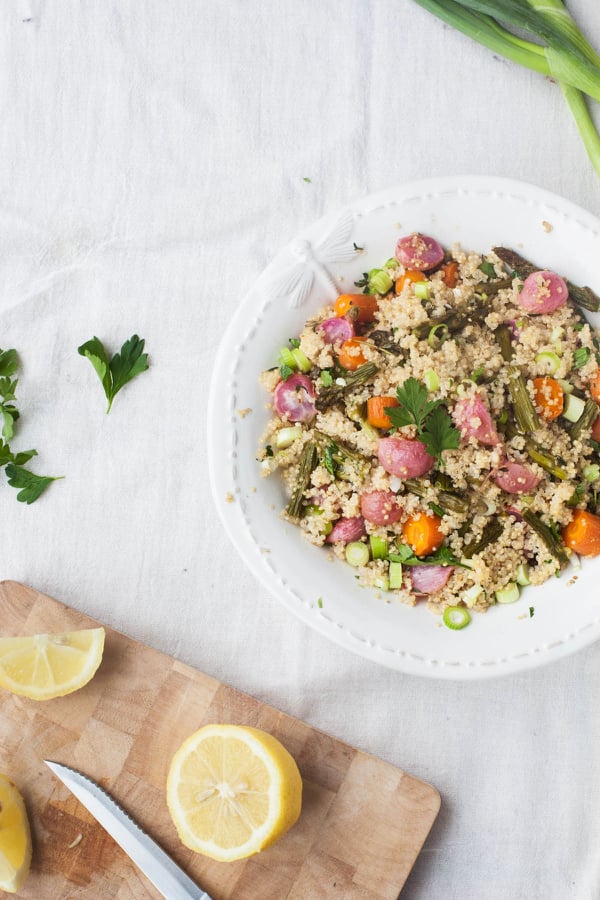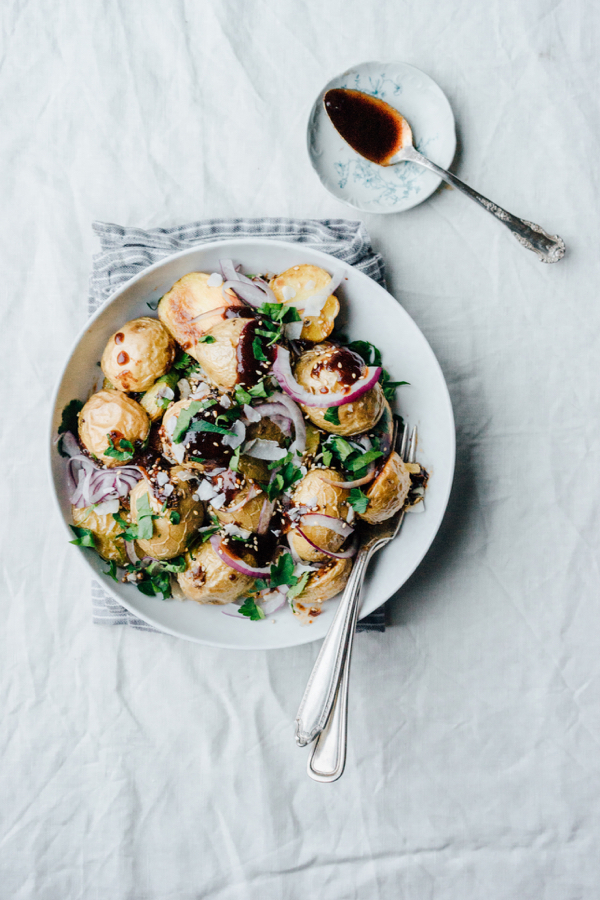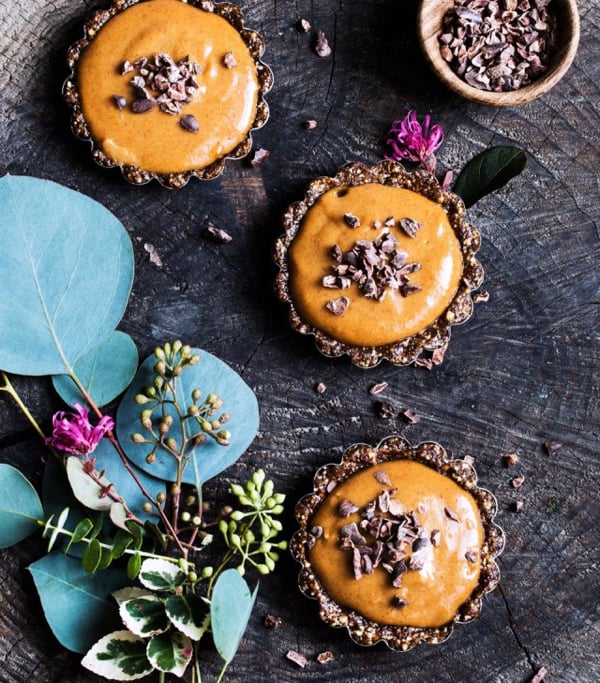Happy Sunday, friends, and happy Easter to those of you who are celebrating.
It was a long and busy week here, but the weekend has brought a lot of happiness–namely, Steven’s and my two year anniversary yesterday. It’s hard to believe that it’s been two years since we met, both in such different places in our lives and living in DC. One move, two grad school programs, one career shift, and four semesters later, we’re still relishing the experience of living together and learning from each other. It has been one of the most important relationships, partnerships, and friendships of my life, and I feel lucky to watch it grow.
So, lots of gratitude this morning. And here are the reads and recipes that have caught my eye.
Recipes
Easter brunch includes dessert, right? This vegan lemon poundcake from Raquel of My California Roots looks totally authentic, and absolutely delectable.
A simple-yet-game-changing spin on avocado toast: give the bread a good rub with sweet, tender roasted garlic (and then top with hemp seeds and crushed red pepper). Thanks for the idea, Meg!
Spring is in the air, and Aimee’s colorful roast spring vegetables with lemon herb quinoa is a perfect way to celebrate. Simple, bright, and healthy!
Pick up a back of baby potatoes and create a comfort food side dish with a spicy twist: Sasha’s masala potatoes with tamarind sauce.
Maya’s easy mini caramel tarts are a perfect embodiment of how simple, nourishing, and beautiful raw food desserts can be. I can’t wait to try them.
Reads
1. Doing the SNAP challenge a few weeks ago made me much more conscious of food waste. Before the challenge, I thought that freezing leftovers and not over-shopping basically exempted me of culpability when it comes to waste, but the truth is that I throw out a lot of vegetable scraps, and I’m not always very creative about how I use up my odds and ends.
I really enjoyed this Lucky Peach interview with Dana Gunders, a staff scientist at NRDC who also is the author of a report entitled “Wasted: How America Is Losing Up to 40 Percent of Its Food from Farm to Fork to Landfill.”
What I like about Gunders’ responses is that she’s tough minded and committed to this cause without being in any way judgmental of individual choices; she understands that food waste is something we all do, and something we could all do more about. When asked whether or not she ever wastes food, she responds:
Oh totally. In my book I have this anecdote about ordering a sandwich in a coffee shop while writing. It came as a salad, drenched in this dressing I was not into. I was not eating that. The irony wasn’t lost on me: I was writing Waste-Free Kitchen Handbook, knowing that this salad is going to get tossed.
It’s not an all-or-nothing proposition. The less food you waste, the less demand signal you’re sending through the chain; the less food that gets grown unnecessarily, the less that gets thrown out. I’d hate for people to be such perfectionists that they don’t try in the first place.
I think this quotation speaks perfectly to the issue of food waste, but it’s also a good way of framing most dietary changes or efforts. Perfectionism–and its tendency to breed easy discouragement–is often the true enemy, whereas small efforts to do better whenever and however we can really do bring about change.
2. A truly fascinating article, published in the British Journal of General Practice, proposes ten commandments for patient-centered care. Read it, and you’ll be struck by how many of these recommendations contradict the aggressive interventions that are common in contemporary US medical care. Examples include “Thou shalt always seek knowledge of the benefits, harms, and costs of treatment, and share this knowledge at all times” (in other words, making the patient aware of the full spectrum of risks associated with a course of treatment), “Thou shalt, if all else fails or if the evidence is lacking, happily consider watchful waiting as an appropriate course of action,” and “Thou shalt treat according to level of risk and not to level of risk factor.”
I also appreciate the first commandment: “Thou shalt have no aim except to help patients, according to the goals they wish to achieve.” The article expands upon this injunction by saying, “When deciding on a treatment, the first diagnosis you need to reach is about the nature of the illness. The second diagnosis you need concerns what the individual would like to achieve.”
This is a powerful way of regarding patient care, one that takes into account not only what is medically advisable, but also what a patient wants. I know that it is the duty of medical professionals to suggest and administer life-saving treatments, and I know that sometimes a doctor’s recommendation comes crashing up against a patient’s own wishes. There’s nothing easy or straightforward about such a scenario. But I believe that there must be a way for physicians to incorporate a patient’s goals into determining a course of treatment–especially as compliance is a huge part of any treatment’s success.
3. I’ve written recently about the health benefits of spicy foods, but I continue to be so interested in the research findings! This Today Show roundup summarizes the major points, such as longevity and pain relief. And as you can see above, it also features an image of the lovely Anya’s spicy strawberry gazpacho.
4. I was touched by this list of advice from women in their 40s to women in their 30s, and I share it with the qualification that I don’t think it’s confined to either decade.
Some of the pieces of advice, such as “love and accept yourself fully” are kind of predictable. But others (“travel more,” “worry less,” “‘no’ is a complete sentence”) really struck me, and they aligned with a lot of the efforts I’m making in my own life these days to be more authentic and assertive, to find my own voice.
5. I was pleased to read this article in the Washington Post about middle schools incorporating mindful eating techniques into their curricula/cultures. The campaign to teach mindful eating skills is intended to help prevent eating disorders of all kinds, including (but not limited to) anorexia, bulimia, and binge eating disorder.
“These programs buffer against eating disorder development,” suggests one of the experts interviewed, “especially when administered during the late middle-school years. That’s a crucial period because it’s when students have been exposed to social the messages that “thin is in” but most have not yet manifested disordered eating habits to obtain a thinner physique.”
Another nutritional counselor who is employed at a boarding school suggests that students “eat without judgment.” She encourages them to refrain from negative body talk and avoid measuring their self-esteem based on the foods they choose to eat.
“This is important,” the article states, “since many of these teenagers struggle with the social and emotional changes of adolescence, including body image dissatisfaction.
For example, when Kip hears students say, ‘I ate the cookies — I was so bad,’ a red-flag sign of negative body talk, she insists that they redefine the experience by using their senses to describe the flavors in the cookie. As an example, if a student feels guilty about eating oatmeal raisin cookies, Kip will ask her to focus and describe the scent and taste of the cinnamon, oatmeal and raisins.”
This stood out to be because it’s similar to advice I give to clients who are expressing guilt or dismay over foods that they perceive to have been overly indulgent: focusing on the sensory experience of an enjoyable food can both help to allay anxiety and also frame that food in a meaningful way. The mindfulness it engenders can be carried forward and help to encourage conscious, considered choices.
There’s no neat cause and effect when it comes to eating disorders, and while culture plays a big role, genetics, family dynamics, and personal history are also critical. There’s no way for us to create a truly preventive environment, but there’s also no reason for us not to do everything we possibly can to encourage language and mealtime practices that encourage body respect. I’m glad that more and more schools are trying.
On this hopeful note, I wish you a lovely, relaxing Sunday. I’ll see you tomorrow with the week’s menu plan!
xo
You might also like
Happy Sunday! I hope you’ve all enjoyed nice weekends. I’ve been reveling in the autumnal weather; I’m so happy that my favorite season is here. To celebrate, here’s a mixture of delectable late summer and early fall food links, most of them of the breakfast variety. Because what’s better than a cozy breakfast on a cool morning? Nothing, I say. Warm with a bowl of creamy coconut millet porridge. This looks absolutely delightful. …and if you’re not quite ready for porridge, you can savor…
For dietitians, the DI year is supposed to be a pre-professional experience, supervised work that prepares us for the realities of practice. One of these realities, I’m starting to realize, is the exercise of judgment. When I started the DI, I assumed that I’d be trained in guidelines and standards that would neatly inform all of my interventions and decisions. I’ve gotten plenty of exposure to evidence-based guidelines and best practices, but what I didn’t understand before the DI—and what I’m coming to…
Happy December, friends! It’s been a somewhat rocky entrance to the month for me, as the past week was full of personal unrest. I slipped into patterns of behavior that feel like me at my worst—stuff so old and habitual and frustrating to me that I don’t even want to write about it. Here’s the interesting news: I’ve somehow managed to regard a bunch of varied relapses—relapses in thought patterns and compulsive behaviors—with an unusually compassionate and non-judgmental gaze. This wasn’t a conscious…
Just about a year ago, I was a month away from beginning my dietetic internship. I knew that my everyday life was about to change, but the whole thing felt so far away and abstract. It had been a long time since I’d worked in clinical environments, to say nothing of working with/for other people. Speaking of that, it had been a hot minute (two years) since I’d taken medical nutrition therapy, and I felt more than a little rusty on a lot…







Leave a Comment
I think the point that the advice for women in their 30s is relEvanton to every age is perfect. If we haven’t learnt to love ourselves then we should do this as soon as possible – it would waste so many lives from being wasted!
When I think of food waste, I think of unused celery that becomes soft and gets tossed (the most common problem in my own fridge), but I’ve never thought about the waste that occurs in the production of food- as she mentions in the interview, with Greek yogurt or other products. Food waste makes me crazy and while I’m a huge meal planner and food prep-er, I’ve begun to not plan for Sunday nights and instead using up whatever is remaining in the fridge. Not only does this reduce food waste for us, but it also forces me to be creative in the kitchen.
Dear Gena, Happy Easter and Happy Anniversary to you and Steven! This is a gorgeous Weekend Reading round-up! I especially loved the beautiful looking avocado toast and the commandment that “watchful waiting” is a viable approach for a doctor and patient to have. This evening my daughter-in-law was telling us about all the salad they have to throw away at her school –even the teachers are not allowed to eat it because it is supposed to be for the kids. We were trying to brainstorm ways not to waster so much food in institutional settings as well as personal ones, so seeing that article on food waste was really timely. You always have such a great range and scope of interest. Also today I was watching old silent home movies my cousin sent me on a thumb drive and reflecting about how beautiful my aunt looked, although she was not model thin–and I wondered if that pencil thin ideal came in in the late 60s with images like that of Twiggy. So I was happy to see this hopeful way of approaching food for middle school students. All great “food for thought..” xoxo
Beautiful round-up, as usual Gena. And congratulations on the two year anniversary. When you find the right person, time seems to fly.
I look forward to your Weekend Reading posts. Love them! Happy Easter to you.
Thanks so much, Becky!
Omgoodness those 10 commandments *swoons*
As I prepare for my follow-up GI appointment tomorrow, the thing I’m MOST afraid of is that my doc won’t be willing to partner with me. I want to be a VERY active participant, not a passive receiver. I have questions for her on about every one of these commandments, and am really hoping that her osteopathic training means she’s a bit more open to exploring ALL the options, and not just high toxicity meds.
The article on mindful eating made me cry. My gut troubles have been a PITA and omg how I miss my regular diet (also: starting no added sugars on the week you’re PMSing is not a good idea) but…it’s also forced me to tune into my body’s hunger signals in a way I’ve been able to before. After all, the consequence is a whole host of uncomfortable symptoms! It’s definitely been an interesting adventure…and fascinating to connect the pieces of my food preferences, eating disorder, and gut stuff. I only wish we all had this mindful eating training!
xo